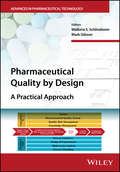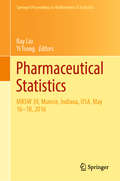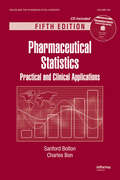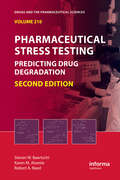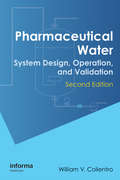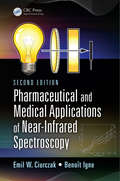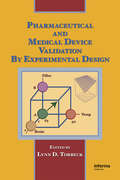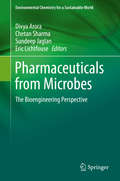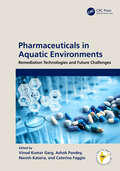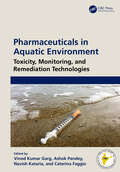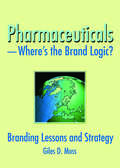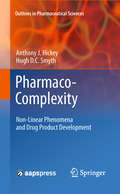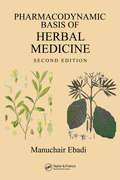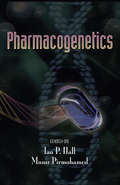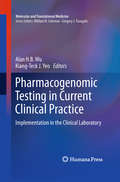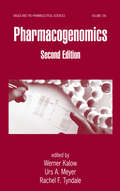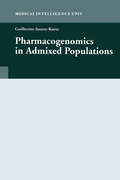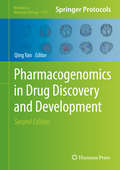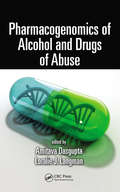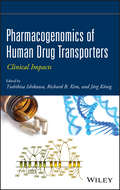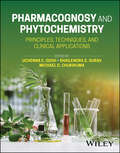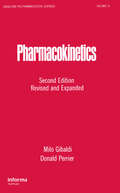- Table View
- List View
Pharmaceutical Quality by Design: A Practical Approach
by Walkiria S. Schlindwein Mark GibsonA practical guide to Quality by Design for pharmaceutical product development Pharmaceutical Quality by Design: A Practical Approach outlines a new and proven approach to pharmaceutical product development which is now being rolled out across the pharmaceutical industry internationally. Written by experts in the field, the text explores the QbD approach to product development. This innovative approach is based on the application of product and process understanding underpinned by a systematic methodology which can enable pharmaceutical companies to ensure that quality is built into the product. Familiarity with Quality by Design is essential for scientists working in the pharmaceutical industry. The authors take a practical approach and put the focus on the industrial aspects of the new QbD approach to pharmaceutical product development and manufacturing. The text covers quality risk management tools and analysis, applications of QbD to analytical methods, regulatory aspects, quality systems and knowledge management. In addition, the book explores the development and manufacture of drug substance and product, design of experiments, the role of excipients, multivariate analysis, and include several examples of applications of QbD in actual practice. This important resource: Covers the essential information about Quality by Design (QbD) that is at the heart of modern pharmaceutical development Puts the focus on the industrial aspects of the new QbD approach Includes several illustrative examples of applications of QbD in practice Offers advanced specialist topics that can be systematically applied to industry Pharmaceutical Quality by Design offers a guide to the principles and application of Quality by Design (QbD), the holistic approach to manufacturing that offers a complete understanding of the manufacturing processes involved, in order to yield consistent and high quality products.
Pharmaceutical Statistics: MBSW 39, Muncie, Indiana, USA, May 16-18, 2016 (Springer Proceedings in Mathematics & Statistics #218)
by Yi Tsong Ray LiuThis book presents the proceedings of the 39th annual Midwest Biopharmaceutical Statistics Workshop (MBSW), held in Muncie, Indiana on May 16–18, 2016. It consists of selected peer- reviewed and revised papers on topics ranging from statistical applications in drug discovery and CMC to biomarkers, clinical trials, and statistical programming. All contributions feature original research, and together they cover the full spectrum of pharmaceutical R&D – with a special focus on emergent topics such as biosimilarity, bioequivalence, clinical trial design, and subgroup identification.Founded in 1978, the MBSW has provided a forum for statisticians to share knowledge, research, and applications on key statistical topics in pharmaceutical R&D for almost forty years, with the 2016 conference theme being “The Power and 3 I’s of Statistics: Innovation, Impact and Integrity.” The papers gathered here will be of interest to all researchers whose work involves the quantitative aspects of pharmaceutical research and development, including pharmaceutical statisticians who want to keep up-to-date with the latest trends, as well as academic statistics researchers looking for areas of application.
Pharmaceutical Statistics: Practical and Clinical Applications, Fifth Edition (Drugs and the Pharmaceutical Sciences)
by Sanford Bolton Charles BonThrough the use of practical examples and solutions, Pharmaceutical Statistics: Practical and Clinical Applications, Fifth Edition provides the most complete and comprehensive guide to the various statistical applications and research issues in the pharmaceutical industry, particularly in clinical trials and bioequivalence studies.
Pharmaceutical Stress Testing: Predicting Drug Degradation, Second Edition (ISSN)
by Steven W. Baertschi Karen M. Alsante Robert A. ReedThe second edition of Pharmaceutical Stress Testing: Predicting Drug Degradation provides a practical and scientific guide to designing, executing and interpreting stress testing studies for drug substance and drug product. This is the only guide available to tackle this subject in-depth. The Second Edition expands coverage from chemical stability
Pharmaceutical Water: System Design, Operation, and Validation, Second Edition
by William V. CollentroA major new work on all aspects of water, the most used raw material ingredient in the pharmaceutical and biotechnology industries-used as an excipient in pharmaceutical formulations, as a cleaning agent, and as a separately packaged product diluent.Drawing on the author's extensive field experience with more than 400 pharmaceutical and related wat
Pharmaceutical and Medical Applications of Near-Infrared Spectroscopy
by Emil W. Ciurczak Benoit IgneSince the completion of the first edition of this book, major developments have occurred in the pharmaceutical industry that have shaped the field of near-infrared (NIR) spectroscopy. A new initiative from the U.S. Food and Drug Administration (FDA) to modernize regulations of pharmaceutical manufacturing and drug quality has helped position NIR sp
Pharmaceutical and Medical Device Validation by Experimental Design
by Lynn D. TorbeckThis title demonstrates how designed experiments are the most scientific, efficient, and cost effective method of data collection for validation in a laboratory setting. Intended as a learn-by-example guide, Pharmaceutical and Medical Device Validation by Experimental Design demonstrates why designed experiments are the most logical and rational ap
Pharmaceutical and Nutraceutical Potential of Cyanobacteria
by Maulin P. Shah Pradeep Verma Michael J. Betenbaugh Muhammad Aamer MehmoodCyanobacteria are the extraordinary microbes that are believed to have started life on Earth. It's been billions of years since they colonized this planet. Now, the question arises, what has made them so successful? The answer to this question lies in their remarkable potential to survive unfavorable environments, their substantial ability to fix the atmospheric carbon through photosynthesis, and their amazing secondary metabolites having antioxidant, osmo-protectants, and stress-tolerance abilities. Research on cyanobacteria has shown that these secondary metabolites and the substantial photosynthetic rates of cyanobacteria can be exploited for environmental, industrial, nutraceutical, and pharmaceutical applications. This book “Pharmaceutical and Nutraceutical Potential of Cyanobacteria” is a collection of 14 book chapters that have covered almost all aspects related to the opportunities, challenges, and potential applications whileemploying cyanobacteria as feedstock for various industrial and environmental applications with a special focus on pharmaceutical and nutraceutical applications. Some sections have also covered the enhanced biosynthesis, extraction, storage, and marketing of the cyanobacterial bioactive compounds (phycobilins, carotenoids, fatty acids, amino acids), and applications of cyanobacteria as food/feed of the future. We believe that this book will provide substantial learning opportunities to the readers including graduate students, academicians, phycologists, policymakers, environmental entrepreneurs, and industrialists. This book could be included in SDG 12 publications.
Pharmaceuticals from Microbes: Impact On Drug Discovery (Environmental Chemistry for a Sustainable World #28)
by Eric Lichtfouse Divya Arora Chetan Sharma Sundeep JaglanThis book has been assembled with the hope of being an authoritative, comprehensive, conceptually sound and highly informative compilation of recent advances describing the concepts of bioengineering in the field of microbiology. It comprises of seven chapters written by eminent authors in their respective fields. Topics included deal with the significant advancement of microbial technology with emphasis on drug delivery strategies for healthcare products, vaccine delivery, biotransformation approaches to generate new molecules, upstream/downstream processing of biopharmaceuticals. It serves as excellent reference material for researchers, students and academicians in the fields of biotechnology, microbiology and pharmaceutical sciences.
Pharmaceuticals from Microbes: Impact on Drug Discovery (Environmental Chemistry for a Sustainable World #28)
by Eric Lichtfouse Divya Arora Chetan Sharma Sundeep JaglanThis book deals with the noteworthy advancement in the production of bioactive metabolites from microbes and their pharmacological significance. It highlights the pharmacological potential of marine microbes and endophytic fungi and their bioactive secondary metabolites. Emphasis is also given on the significance of probiotics and their specialized molecules in human health and disease as well as their role in dietary intervention for reducing the risk of non-alcoholic fatty liver disease. This work also serves as excellent reference material for researchers, students and academicians in the field of natural product chemistry, pharmacology and applied microbiology.
Pharmaceuticals in Aquatic Environments: Remediation Technologies and Future Challenges
by Ashok Pandey Vinod Kumar Garg Navish Kataria Caterina FaggioThis book covers pharmaceutical residue dispersion in the aquatic environment and its toxic effect on living organisms. It discusses conventional and advanced remediation technologies such as the use of biomaterials for the sequestration of contaminants, nanotechnology, and phytoremediation. The book includes topics such as the removal of pharmaceutical and personal care product residues from water bodies, green chemistry, and legal regimens for pharmaceuticals in the aquatic environment. It also covers the application of modified biochar in pharmaceutical removal.FEATURES Explores the management of the environment through green chemistry Describes phytoremediation technology for decontamination of pharmaceutical-laden water and wastewater Covers the detection methods and quantification of pharmaceutical residues in various contaminated sources Discusses ecotoxicological aspects and risk assessment of pharmaceuticals in the aquatic environment Reviews degradation and treatment technologies including nanotechnology, biomaterials, and biochar This book is meant for pharmaceutical, toxicology, and environmental science industry experts and researchers.
Pharmaceuticals in Aquatic Environments: Toxicity, Monitoring, and Remediation Technologies
by Ashok Pandey Vinod Kumar Garg Navish Kataria Caterina FaggioThis reference book compiles up-to-date research about the threat and management of pharmaceutical residue dispersion in the aquatic environment. It explores the risk analysis and short- and long-term health issues created due to the ingestion of pharmaceutical-contaminated food products and drinking water. The book focuses on the methods of removal and degradation processes of pharmaceutical residues from contaminated sources. It emphasizes the importance of eco-friendly and advanced treatment technology for the sustainable management of wastewater and drinking water supply. The book is meant for industry experts and researchers in pharmaceutical science, toxicology, and environmental sciences.
Pharmaceuticals-Where's the Brand Logic?: Branding Lessons and Strategy
by Giles David MossInsights and analysis that challenge current thought on consumer branding theory and strategy Pharmaceutical companies need to go beyond simply relying on strong sales forces and innovative research and development to succeed. Effective branding strategy is essential. PharmaceuticalsWhere’s the Brand Logic?: Branding Le
Pharmaco-Complexity
by Anthony J. Hickey Hugh D.C. SmythThe historical approach to the interpretation of physical, chemical and biological phenomena has been to consider relationships with causative factors that can be reduced to linearity allowing simple and direct interpretation. However, it is increasingly evident that there is often more information in the data than linear interpretations allow. The current capacity for computers to assist in identifying non-linear relationships allows greater interpretation of data which illuminates the phenomena allowing the information to be translated into knowledge that can be used wisely to promote various desirable pharmaceutical outcomes. This short volume is intended to stimulate the reader to contemplate research and development areas in which the data might be more accurately interpreted to allow greater understanding and ultimately control of the pharmaceutically complex phenomena.
Pharmacodynamic Basis of Herbal Medicine
by Manuchair EbadiContinuing in the tradition of the acclaimed first edition, Pharmacodynamic Basis of Herbal Medicine, Second Edition examines in extensive detail the physiologic effects of complimentary and alternative therapies, foods, supplements, vitamins, and traditional herbal remedies. The author considers the site, mode, and mechanism of action to ex
Pharmacogenetics
by Ian P. Hall Munir PitrmohamedThe only source on the subject to offer both an overview and a disease-based approach, this reference text spans the wide array of technical, methodological, regulatory, and ethical issues related to pharmacogenetics and stresses the impact of pharmacogenetic data on patient care and management. Providing expertly selected references, tables, and f
Pharmacogenomic Testing in Current Clinical Practice
by Kiang-Teck J. Yeo Alan H. WuWhile the basic principles of personalized medicine and pharmacogenomics has been covered by numerous texts, there are none to date that focuses on the specific tests themselves that are in current clinical practice and those that are being proposed for implementation in the near future. Pharmacogenomic Testing in Current Clinical Practice: Implementation in the Clinical Laboratory focuses almost entirely on the specifics of each test that is needed to implement these tests into a clinical laboratory. This volume presents the first compilation of the tests currently in routine clinical use. The chapter authors of this unique and invaluable title comprise a range of renowned authorities and investigators who have conducted the essential clinical trials necessary to justify pharmacogenomic testing today. The book is divided into four parts: Basic Concepts, Specific Pharmacogenomic Targets, Drugs that Cause Delayed Hypersensitivity, and Miscellaneous Drugs. Each author provides a pharmacologic background on the target drug, the need for pharmacogenomic testing, and how results can be translated into clinical decisions. Where appropriate, case studies are given to illustrate typical clinical scenarios. An extensive bibliography is provided so that the reader can refer to the original studies. This well-designed resource will appeal to clinical laboratory directors who are contemplating or assigned the task of establishing a pharmacogenomics laboratory and a wide range of clinicians who must interpret results of testing. Focused and immensely useful, Pharmacogenomic Testing in Current Clinical Practice: Implementation in the Clinical Laboratory is a timely and outstanding contribution to the literature and will be instrumental in defining this rapidly growing field.
Pharmacogenomics (Drugs and the Pharmaceutical Sciences)
by Werner Kalow Rachel F. Tyndale Urs A. MeyerReflecting the shift from genetics to genomics in the pharmaceutical sphere, this Second Edition traces the evolution of the science of pharmacogenetics and gathers research from the forefront of the field-spanning the most influential breakthroughs in molecular diagnostics, metabonomics, proteomics, bioinformatics, disease mapping, pharmacodynamic
Pharmacogenomics in Admixed Populations
by Dr. G. Suarez-KurtzEthnic specificity has become an integral part of research in the overlapping sciences of pharmacogenetics and pharmacogenomics. Pharmacogenomics in Admixed Populations was conceived to compile pharmacogenetic/-genomic (PGx) data from peoples of four continents: Africa, America, Asia and Oceania, where admixture and population stratification occurs
Pharmacogenomics in Drug Discovery and Development
by Qing YanThe field of pharmacogenomics arose to develop personalized medicine, or medicine that deals with the complexity of the human body. In this book, leading experts present methodical, state-of-the-art contributions covering topics from individual molecules to systemic diseases, examining both fundamental concepts and advanced technologies. The volume begins by exploring cutting-edge technologies used to pursue systems-based pharmacogenomics, followed by extensive chapters on gene-drug interactions and the use of pharmacogenomics in therapeutics of diseases. This book is ideal for scientists striving to transform disease treatment into disease prevention.
Pharmacogenomics in Drug Discovery and Development (Methods in Molecular Biology #2547)
by Qing YanThis new edition offers a state-of-the-art and integrative vision of pharmacogenomics by exploring new concepts and practical methodologies focusing on disease treatments, from cancers to cardiovascular and neurodegenerative disorders and more. The collection of these theoretical and experimental approaches facilitates problem-solving by tackling the complexity of personalized drug discovery and development. Written by leading experts in their fields for the highly successful Methods in Molecular Biology series, the book aims to provide across-the-board resources to support the translation of pharmacogenomics into better individualized health care. Authoritative and up-to-date, Pharmacogenomics in Drug Discovery and Development, Third Edition aims to aid researchers in approaching the challenges in pharmacogenomics and personalized medicine with the introduction of these novel ideas and cutting-edge methodologies.
Pharmacogenomics of Alcohol and Drugs of Abuse
by Amitava Dasgupta Loralie J. LangmanPharmacogenomics is the basis of personalized medicine, which is said to be the medicine of the future. Understanding genetic variation in drug and alcohol response is vital for professionals working in rehabilitation programs. The same principles that are applicable for therapeutic drugs are also applicable for drugs of abuse. Pharmacogenomics can
Pharmacogenomics of Human Drug Transporters: Clinical Impacts
by Richard B. Kim Toshihisa Ishikawa Jörg KönigSets the foundation for safer, more effective drug therapies With this book as their guide, readers will discover how to apply our current understanding of the pharmacogenomics of drug transporters to advance their own drug discovery and development efforts. In particular, the book explains how new findings in the field now enable researchers to more accurately predict drug interactions and adverse drug reactions. Moreover, it sets the foundation for the development of drug therapies that are tailored to an individual patient's genetics. Pharmacogenomics of Human Drug Transporters serves as a comprehensive guide to how transporters regulate the absorption, distribution, and elimination of drugs in the body as well as how an individual's genome affects those processes. The book's eighteen chapters have been authored by a team of leading pioneers in the field. Based on their own laboratory and clinical experience as well as a thorough review of the literature, these authors explore all facets of drug transporter pharmacogenomics, including: Individual drug transporters and transporter families and their clinical significance Principles of altered drug transport in drug–drug interactions, pharmacotherapy, and personalized medicine Emerging new technologies for rapid detection of genetic polymorphisms Clinical aspects of genetic polymorphisms in major drug transporter genes Future research directions of drug transporter pharmacogenomics and the prospect of individualized medicine Pharmacogenomics of Human Drug Transporters opens the door to new drug discovery and development breakthroughs leading to safer and more effective customized drug therapies.The book is recommended for pharmaceutical scientists, biochemists, pharmacologists, clinicians, and genetics and genomics researchers.
Pharmacognosy and Phytochemistry: Principles, Techniques, and Clinical Applications
by Shailendra S. Gurav Uchenna E. Odoh Michael O. ChukwumaKey information on plant-based chemical and pharmacology research, from basics and principles through recent technological advances Pharmacognosy and Phytochemistry provides an overview of the basics of pharmacognosy and phytochemistry from early principles through contemporary advances like molecular pharmacognosy. The book covers the classification of crude drugs, complementary and alternative medical (CAM) systems, adulteration and evaluation of drugs, extraction methods of plant drugs, and ethnobotany and ethnopharmacology. The book also reviews the historical overview, therapeutic application, cultural and ecological dimensions of plant-based medicines. Other key chapters discuss biotechnology and clinical pharmacognosy. Written by a group of expert contributors, Pharmacognosy and Phytochemistry reviews sample topics including: Methodologies for extracting bioactive compounds and techniques to perform qualitative and quantitative phytochemical analysisTherapeutic potential of plant secondary metabolites and the processes of isolation, purification, and characterization of herbal drugsBiological screening methods and biosynthetic pathways of phytopharmaceuticals, pharmaceutical aids, nutraceuticals, cosmeceuticals, pesticides, and allergensComparative phytochemistry, chemotaxonomy, and the emerging field of marine pharmacognosy Combining traditional knowledge with modern advancements to provide a holistic understanding of two important fields, Pharmacognosy and Phytochemistry serves as an excellent resource for students, researchers, and practitioners.
Pharmacokinetics (Drugs and the Pharmaceutical Sciences)
by Milo Gibaldi Donald PerrierThis book is based on research papers and commentaries on pharmacokinetic methods and applications published since 1975. It offers detailed examinations of new developments in the pharmacokinetic field with enhanced clarity of presentation and simplified organization.
